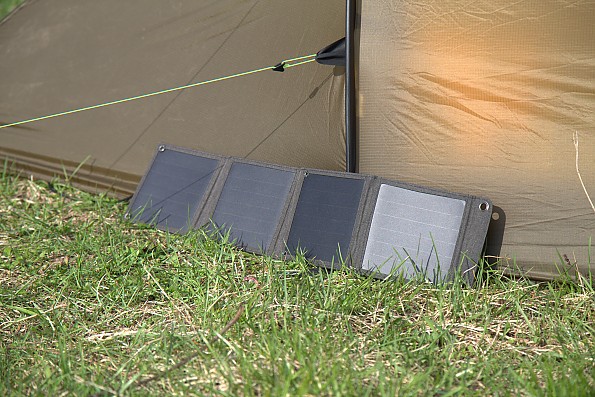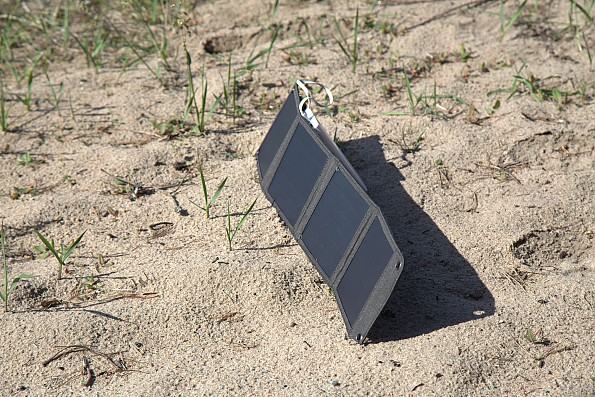Suaoki SunPower 14W Solar Charger
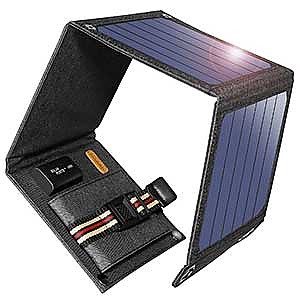
Lightweight, compact, and inexpensive solar charger, providing adequate power supply in stationary state. The build quality is surprisingly good, but there is still some room for improvement. It has somewhat limited use scope due to inability to provide adequate power on the go. Also its effective usage is not really straightforward and requires sunny weather.
Pros
- Adequate power output even at 60°N (7W average in real world use)
- Can charge the smartphones (well, at least my own Sony Z5 Compact)
- Very lightweight at 350 grams (12 oz)
- Compact (6x6 in) and strong in folded state
- Easy to direct at the sun on the stops
- Good build quality
- Very good value for money
Cons
- Single USB port limits the peak power output
- No QuickCharge support
- Mostly useless in moving state, poor options for attaching to the gear
- Will not work in shade (like any other portable solar panel)
- Lack of internal power meter
Background
My first experience in solar panels was GoalZero Nomad 7, a gift from our close friend. In folded state it was about A5-sized (half of Letter), the weight was 500 grams (1 lb 2 oz), and it was rated for 5 Watts of USB output. I haven’t used it actively, but here are some quick figures. In sunny day it provided about 4.5 Watts in perfect conditions, but in real life (e.g. not 100% aligned with the sun) the output was closer to 2.5 Watts. In shade (e.g. with sun yielding to clouds or blocked by a tree) it hardly provided 0.5 Watts, or nothing.
So we haven’t really used this solar panel beyond some tests, as its weight and dimensions were thrice the large power bank (like my Xiaomi 20K), and its power capabilities in cold and rainy Russian summer were quite underwhelming.
But with our child growing we started spending more time showing him educational movies before sleep. Of course that required more energy than we were used to spend. And also we’ve scheduled a trip to Northern Belarus, where we didn’t expect any facilities for recharging the batteries. In order to free ourselves from the power outlets, I started seeking for a good solar panel.
After using the Nomad 7, I considered only 2 times more powerful solar panels (with 10-Watt USB power and up), as we don’t benefit from lots of sun here at 60°N. Also the smallish solar panels struggle to power the modern high-current electronics, such as smartphones. In the meantime the solar panel of choice in folded state shall be smaller than our old Nomad 7. We travel on bike with periodical hopping in and out the trains, so the larger the solar panel (like popular full Letter/A4-sized models), the more probability to break it.
After studying some user reviews I found the sensible option — Suaoki SunPower 14W Solar Charger.
First impressions
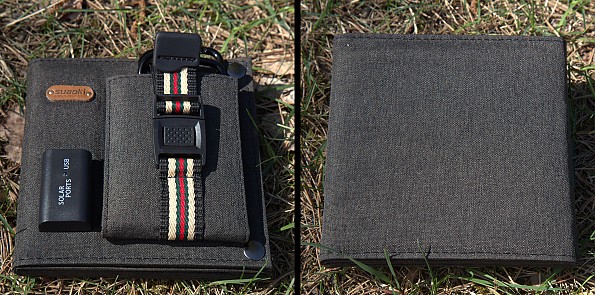 In folded state; striped QR strap covering the pocket is visible
In folded state; striped QR strap covering the pocket is visible
The solar panel comes in simple but neat carton box with 2 carabiner clips (for securing the unfolded panel on your gear with 2 grommets on ONE end), MicroUSB cable and instruction manual. The build quality is as good as it gets, I have no complaints. The outer side of solar panel is made of very thick and strong fabric with some plush underneath. In folded state it looks and feels like a good large square wallet.
The solar charger has the rated USB power of 10 Watts (single USB port) and it folds 4 times, effectively becoming smaller than Nomad 7. Also it costs 3 times cheaper than branded equivalents, which are usually much bigger (about full A4/Letter size in folded state) and heavier.
The folded dimensions are very small at 150✕145 mm (5.9✕5.7 in), the height is 20 mm (0.8 in) without the power converter and accessory pocket, and about 40 mm (1.6 in) in total. Unfolded dimensions — 640✕145 mm (25✕5.7 in). Weight — just 350 grams (12 oz) without the included carabiners and MicroUSB cable. I really like the quad-folding design of this panel, as it feels really small and tough in folded state in comparison to dual folding Nomad 7.
The pocket on the face side holds the mobile device with dimensions up to 135✕75 mm, which limits the screen size to 4.5-5.0”. So most modern smartphones will not fit there. In this pocket I carry the USB cable and the power meter, as my use case does not require putting the phone into this pocket, instead I use the charged device as a kickstand.
For measuring the power output I use the 5-dollar Chinese USB multimeter which displays the instant voltage, current, power, and resettable counters of time and transferred energy (so I can easily calculate the average power value within the time period). Unfortunately a measuring instrument is not included into the design of solar panel, which could be a killer feature at cheap price. Instead I had to use the stand-alone meter, reducing the overall usability. I could have easily glued the USB multimeter in place, if I used this charger very often. :-)
Even at home on the window the solar panel easily provided average 4 Watts in far less than perfect conditions (end of day, behind the window with 3-layer glass, not aimed directly at the sun). After testing with most of my USB-powered gadgets I’ve seen no problems with charging of any of them. Xiaomi 20K Powerbank — OK, Sony Xperia Z5 Compact — OK, Huawei Mediapad 8.4 — OK, generic USB charger for DSLR battery — OK, Fenix AA/AAA/18650 charger — OK.
Stationary usage experience
The stretched shape helps in convenient placement on the ground
In stationary state the solar panel is placed on the ground and easily aligned with the sun. Using the charged device as an improvised kickstand is also quite convenient due to small width of unfolded panel. The panel is quite stable on the ground (but may be flopped by wind gust) and easily moved for tracking the sun (each 30-60 minutes or so). Notably, on the stops adequate power output is guaranteed even with less than perfect alignment with the sun (up to 30 degrees of misalignment were OK).
In my 2-week-long cycling trip in Belarus I was using this solar charger with great success due to mostly clear and sunny weather, and also the fact that we were on the move only 3-4 hours per day. I had no problems with strength and durability of panel during the 14 days of rough handling inside my backpack.
Having several hours of staying on the sun every day, I was able to keep our devices in fully charged state during the entire trip. Here they are: two smartphones, tablet PC, DSLR camera, spherical camera, GPS unit, two headlamps, two flashlights, fitness tracker. Of course I was prepared to a failure of my solar panel and carried a good amount of spare batteries, plus fully charged 20K power bank.
BTW, is anybody interested in a review of spherical camera?
On the stops the average hourly power output from the solar panel was about 5-7 watts, depending on initial battery level of charged device (the lower the battery, the higher power may be accepted). So while staying on the sun I could fill the phone battery from 60% to 95% (or tablet from 80 to 95%) in less than an hour.
Actually I’ve never seen any of my devices accepting more than 1.5 A from ANY power source, which equals to 7.5 Watts in case of 5 Volt solar output. Probably that were my USB cables limiting the current to 1.5 A, but it’s also possible that my devices could not accept 2 A at all. So I cannot say anything about the claimed ability to supply 10 W via USB.
It would be great if the USB power converter could support the QuickCharge technology (allowing the faster power transfer at 9 Volts). Alternatively, a second USB output port could have utilized full 10 Watts and raised some other limitations, but it’s not there.
In cloudy weather and right before the sunset I could get only around 1-2 watts average, and my phone refused to charge (see detailed explanation below). In such cases I was using my 20K power bank as auxiliary storage for solar energy. Also I kept it connected to the solar panel when there was nothing to charge anymore, so the power bank also displayed above 75% of charge throughout the trip.
Mobile usage experience
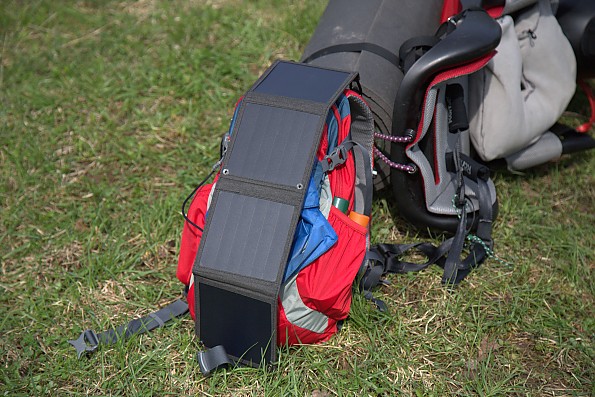 The top is secured with carabiners, the bottom with the strap, but the panel is too long for this 18L backpack
The top is secured with carabiners, the bottom with the strap, but the panel is too long for this 18L backpack
Using the included carabiners for securing the panel on the backpack was inconvenient due to the large length of unfolded panel, and only 2 grommets on one end. It’d be nice to have two more on the other end, but there’s only a strap, which can be used for securing that end with some success.
Putting the solar panel on the backpack proved itself useless: the power flow was very little, only about 1-2 watts average in perfect conditions (hot and sunny day, with sun shining from the back).
The problem is that in moving state it’s almost impossible to achieve good alignment with the sun, even while moving in favorable direction. The solar panel physics requires that all four cells shall be aligned with the sun about equally well. So with sun shining NOT directly on my back (or e.g. while riding under trees) the power output was next to zero.
After some trials I stopped trying to put the panel on the backpack and continued using it on the stops only.
Conclusion
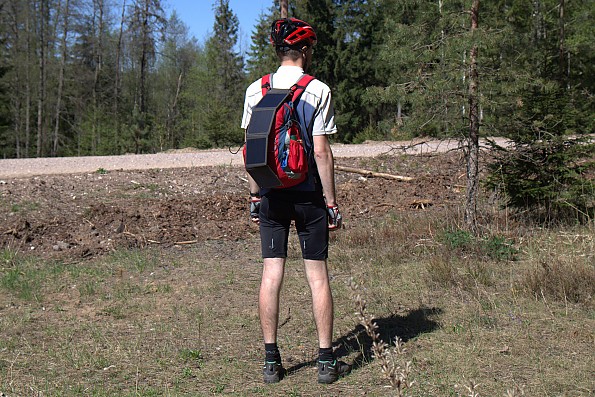 Ineffective way of use (note that I ride the bike in sports style, with body leaned forward)
Ineffective way of use (note that I ride the bike in sports style, with body leaned forward)
To my opinion, a solar charger is only useful in long trips, lasting several days and more. Thanks to sunny weather, we were able to spend much energy in our trip without any worries about the power sockets (which weren’t available during the entire trip). Contrary in weekend trips the solar charger is not very useful, and a power bank of similar weight will serve you much better (note that a solar charger also requires a power bank for optimum performance). Also the problems will arise in cloudy weather — you’ll get a 10-th of usual power at best. In week-long rains a solar charger is simply a dead weight.
So the solar panel is not for everyone and every trip, I would personally avoid spending 100 bucks on it.
But in this case, considering the low price of Suaoki charger, I’m really happy with my purchase and may recommend it to fellow outdoor enthusiasts. I also concluded that this form-factor (14W, folding 4 times) is well suited for cyclists and hikers: larger batteries are much less portable (with disputable advantage in power output, as most USB devices will not accept THAT much power), and the smaller ones (less than 10W) are simply ineffective.
Some hints for effective usage of portable sun power are presented below.
APPENDIX
Getting used to the solar panel
To use the solar panel most effectively, one must understand how a Li-Ion battery is charged.
1. The charging controller accepts power from USB source in dependence on current battery level and temperature. At the end of charging process (above 80%) the current gradually declines to zero for better cell longevity. Also many smallish or old devices (including some old power banks) cannot physically drain more than 1-5 watts from USB power source.
So in many cases the battery will not accept full power from solar panel, and valuable photons will be lost (or you’ll be given a margin for misalignment with the sun). Hint: Avoid using the solar power for topping the battery above 90%, if you have other devices waiting to be charged.
2. In many “smart” devices (smartphones, tablets and so on) the charging controller is designed with constant high input power in mind. Conversely, the current and voltage in solar charger may jump back and forth following the changes in solar energy (affected by cloud coverage, shade, or changing the angle in relation to sun).
So in partially cloudy days and especially in moving state some devices will not accept ANY power from the solar panel. The less the nominal power of your solar panel, the more problems you get with such devices. I’d recommend getting the USB power meter (which can display the wattage, not only current and voltage) to check if your devices are “smart” enough to reject the ever-changing power flow from the solar panel. Such devices can be charged directly only in stationary state in clear sunny weather, using the powerful enough solar cell (like this one).
3. Indirect charging your devices via the power bank is lossy. But it’s still the best (and sometimes the only) choice in case of:
- tiny low-power devices which cannot physically accept much power;
- “too smart” devices which require constant high power flow for charging (especially in case of weak 5-7W solar panels);
- topping the batteries above 90%.
Not using the power bank in such scenarios means wasting the solar energy. But in situations with limited sun shining it’s advised to charge the energy consumers directly from the sun, not via the Power Bank.
Notes on solar chargers
While charging any battery-powered device, avoid putting it under direct sun rays. Overheating will cause the charging to stop, in some cases that may lead to damage of battery and in extreme scenarios — to fire.
Also note that the more sophisticated power equipment you're using, the more probability of failure you get. So in extreme conditions, when the success of entire trip may depend on electric power, you shall not fully rely on solar charger, dynamo hub or Power Bank. There shall be always an independent backup.
I really like my Garmin GPSMap 64s unit, as it uses the AA batteries which may be found everywhere in the world. (Of course that’s not my only nav device, and it has its own backup.)
Source: bought it new
Price Paid: 28 USD


